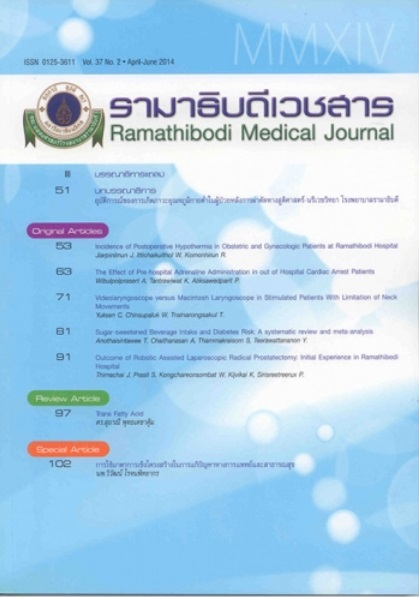Outcome of Robotic Assisted Laparoscopic Radical Prostatectomy: Initial Experience in Ramathibodi Hospital
Main Article Content
Abstract
Background: Robotics assisted laparoscopic prostatectomy (RALRP) has been shown to improve functional outcomes when compared to open or laparoscopic prostatectomy with similar oncologic results. It has become a famous procedure for treating patients with localized prostate cancer. The program of RALRP has just been started at Ramathibodi Hospital for about a year. The feasibility of this procedure in our institution has to be established.
Objective: To evaluate the feasibility of the RALRP that was performed early at Ramathibodi Hospital.
Methods: Medical records of 30 patients with clinically localized prostate cancer who underwent RALRP by two laparoscopic-experienced urologists in Ramathibodi Hospital from May 2013 to January 2014 were retrospectively reviewed including outcomes, complications, and cost per admission for RALRP.
Results: Mean operative time was 4.2 hours (range 2.0 – 7.3) and mean estimated blood loss was 527 mL (range 100 – 2200) without blood transfusion requirement in 80% of all patients. There were no intraoperative complications and no conversions to open surgery. Twenty-four patients (80%) had pT2 disease and 6 patients had pT3 disease. Positive surgical margin rate was 53%. There were 20% minor post-operative complications, and no major post-operative complications and mortalities. Mean length of hospital stay was 8 days (range 5 - 19) and mean duration of urethral catheter indwelling was 11 days (range 5 – 22). Mean post-operative serum PSA level was 0.08 ng/mL (range 0.00 - 1.12) with mean follow-up duration of 86 days. Total cost per admission for RALRP was 126,875 baht (range 50.968 - 343,027)
Conclusions: RALRP for prostate cancer in Ramathibodi Hospital is safe but additional studies are needed to indicate the feasibility of this procedure.
Article Details
References
Khuhaprema T. Current cancer situation in Thailand. Thai J Toxicology. 2008;23:60-61.
Heidenreich A, Bastian PJ, Bellmunt J, et al. EAU guidelines on prostate cancer. part 1: screening, diagnosis, and local treatment with curative intent-update 2013. Eur Urol. 2014;65(1):124-137. doi:10.1016/j.eururo.2013.09.046.
Lowrance WT, Parekh DJ. The rapid uptake of robotic prostatectomy and its collateral effects. Cancer. 2012;118(1):4-7. doi:10.1002/cncr.26275.
Berryhill R Jr, Jhaveri J, Yadav R, et al. Robotic prostatectomy: a review of outcomes compared with laparoscopic and open approaches. Urology. 2008;72(1):15-23. doi:10.1016/j.urology.2007.12.038.
Rocco B, Matei DV, Melegari S, et al. Robotic vs open prostatectomy in a laparoscopically naive centre: a matched-pair analysis. BJU Int. 2009;104(7):991-995. doi:10.1111/j.1464-410X.2009.08532.x.
Ficarra V, Novara G, Ahlering TE, et al. Systematic review and meta-analysis of studies reporting potency rates after robot-assisted radical prostatectomy. Eur Urol. 2012;62(3):418-430. doi:10.1016/j.eururo.2012.05.046.
Novara G, Ficarra V, Mocellin S, et al. Systematic review and meta-analysis of studies reporting oncologic outcome after robot-assisted radical prostatectomy. Eur Urol. 2012;62(3):382-404. doi:10.1016/j.eururo.2012.05.047.
Yossepowitch O, Briganti A, Eastham JA, et al. Positive surgical margins after radical prostatectomy: a systematic review and contemporary update. Eur Urol. 2014;65(2):303-313. doi:10.1016/j.eururo.2013.07.039.
